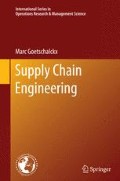Abstract
Learning Objectives
After you have studied this chapter, you should be able to:
-
Understand the stochastic nature of a forecast and how to treat it in a scientific manner.
-
Know the different types of forecasts and their main characteristics.
-
Know the different types of forecasting methods and their main characteristics.
-
Compute and interpret measures of forecast accuracy.
Access this chapter
Tax calculation will be finalised at checkout
Purchases are for personal use only
References
Ballou, R. H. (1998). Business logistics management (4th ed., Chap. 9). Englewood Cliffs: Prentice-Hall.
Box, G. E., & Jenkins, G. M. (1970). Time series analysis, forecasting and control. San Francisco: Holden Day.
Brockwell, P., & Davis, R. (1996). Introduction to time series and forecasting. New York: Springer.
Dalkey, N. C., & Helmer, O. (1951). The use of experts for the estimation of bombing requirements: a project Delphi experiment. Rand Corporation Report RM-727-PR, November 1951.
Gross, C. W., & Peterson, R. T. (1983). Business forecasting (2nd ed.). New York: Wiley.
Hayter, A. (1996). Probability and statistics for engineers and scientists. Boston: PWS Publishing Company.
Linstone, H., & Turoff, M. (Eds.). (1975). The Delphi method: Techniques and applications. London: Addison-Wesley.
Montgomery, D. C., & Johnson, L. A. (1976). Forecasting and time series analysis. New York: McGraw-Hill.
Montgomery, D., Peck, E., & Vining, G. (2001). Introduction to linear regression analysis. New York: Wiley.
Nahmias, S. (2000). Production and operations analysis (4th ed., Chap. 2). Boston: McGraw-Hill.
Saffo, P. (2007). Six rules for effective forecasting. Harvard Business Review, 85(7/8), 122–131.
Wilson, J. H., & Keating, B. (1990). Business forecasting. Homewood: Richard D. Irwin.
Yurkiewicz, J. (2003). Forecasting software survey. ORMS Today, pp. 44–51.
Author information
Authors and Affiliations
Corresponding author
Rights and permissions
Copyright information
© 2011 Springer Science+Business Media, LLC
About this chapter
Cite this chapter
Goetschalckx, M. (2011). Forecasting. In: Supply Chain Engineering. International Series in Operations Research & Management Science, vol 161. Springer, Boston, MA. https://doi.org/10.1007/978-1-4419-6512-7_3
Download citation
DOI: https://doi.org/10.1007/978-1-4419-6512-7_3
Published:
Publisher Name: Springer, Boston, MA
Print ISBN: 978-1-4419-6511-0
Online ISBN: 978-1-4419-6512-7
eBook Packages: Business and EconomicsBusiness and Management (R0)

